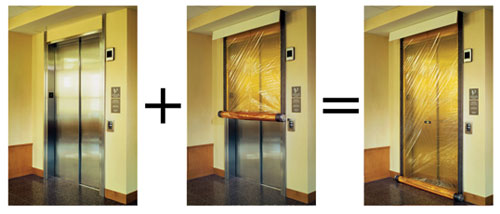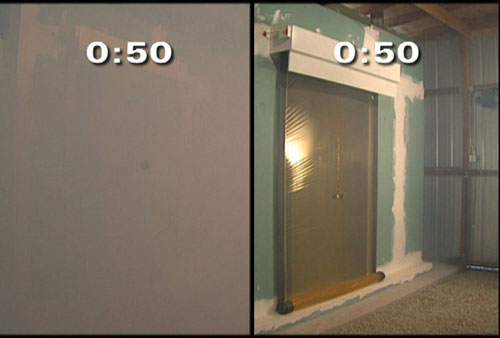Design Alternatives to the Enclosed Elevator Lobby: Fire and Smoke Safety Solutions
Alternative Means and Modes
As previously mentioned, the code doesn't explicitly describe every alternate solution available to architects for replacing the enclosed elevator lobby on a project. Section 104.11 allows for alternative means and methods of construction that are equal to or superior to the requirements in the code. The International Code Council (ICC) evaluates various products and design solutions and tests them against the initial enclosed elevator lobby standards. This agency approves or denies the application of that solution as a substitute for an enclosed elevator lobby in its published Evaluation Service Report (ESR). Two products that have been approved by the ICC as viable substitutes to an enclosed elevator lobby are horizontal sliding accordion doors and rolling magnetic gasketing systems.
Accordion Doors
Accordion doors are large, steel doors that hide in a pocket in the wall and deploy horizontally along a track in the ceiling when a fire is detected. These products can bend around corners, unusual shapes, escalators, and other building fixtures, providing a highly flexible fire and smoke barrier solution. The doors can be fire-rated and use gaskets to create a seal with the walls, ceiling and floor once fully deployed to provide the requisite smoke resistance. These products slide into place to create an enclosed elevator lobby if a fire occurs, but are housed out-of-sight, allowing architects to leave the space open during regular day-to-day activities. Even though these accordion doors are often hidden, they still require that architects architects earmark a certain amount of space for the enclosed elevator lobby that will be created when the doors deploy.
Rolling Magnetic Gasketing System
A rolling magnetic gasketing system creates a smoke barrier at the elevator shaft opening by deploying a reinforced, transparent, polymide film down over the shaft door when smoke is detected in the area. The edges of the film are equipped with flexible magnetic strips that adhere to metal rails on either side of the doorway providing a virtually air-tight seal. The ICC recognizes the combination of the normally fire-rated elevator hoistway doors and the rolling magnetic gasketing system, which deploys an air-tight film over the shaft door, as an approved alternative for an enclosed elevator lobby. The fire-rated elevator doors provide the requisite fire protection and the UL 1784-tested rolling magnetic gasketing system provides the necessary smoke protection.
 |
The combination of the fire-rated elevator doors and the UL 1784-tested rolling magnetic gasketing system meets the IBC code requirement that prescribes an enclosed elevator lobby at the elevator shaft. Photo courtesy of Smoke Guard, Inc. |
Â
This solution eliminates the need to incorporate an enclosed elevator lobby in the architectural design, returning an incredible amount of space to the floorplate. "These rolling magnetic gasketing systems essentially create a smoke containment vestibule right in front of each elevator door opening that is three inches deep, rather than a couple hundred square feet. They are less obtrusive to circulation flows in a building and aesthetically occupants don't feel like they are getting off of the elevator into a little alcove or box. In fact, they won't even notice it," states Mike DeOrsey, Project Manager, Burt Hill, Boston, MA.
Many design professionals believe that specifying accordion doors and rolling magnetic gasketing systems in front of the elevator opening meets the additional door criteria (Exception 3) more effectively and aesthetically than swing doors.
Performance Comparison
Available alternatives to the traditional enclosed elevator lobby include: swing doors, accordion doors, elevator pressurization systems and rolling magnetic gasketing systems. While each of these appropriately provides the fire and smoke barriers required by the IBC, they are very different solutions in terms of the air leakage performance, life cycle maintenance, and overall costs associated with each.
Air Leakage Performance
Air leakage describes the amount of air and smoke that passes from one side of the smoke barrier to the other. Lower air leakage rates indicate better, more air-tight smoke and draft control assemblies, because less smoke and air is able to breach the barrier and migrate further into the building or elevator shaft. The UL 1784 air leakage standard tests the maximum allowable air leakage rate at three cubic feet per minute (cfm) per square foot of door opening, measured at defined pressures and temperatures. To meet this air leakage test, the doors or opening protectives that serve as smoke and draft control assemblies must be designed to fit snugly in the space. As a point of reference, standard fire-rated elevator doors are allowed a 3/8 inch gap between the door and the frame by NFPA 252 standard. This fractional gap can allow up to 900 cubic feet of smoke per minute to pass through the elevator opening, when the doors are in the closed position. Fire-rated elevator doors are a great example of an approved fire rated opening protective that is not an acceptable smoke and draft control assembly.
 |
The combination of the fire-rated elevator doors and the UL 1784-tested rolling magnetic gasketing system meets the IBC code requirement that prescribes an enclosed elevator lobby at the elevator shaft. Photo courtesy of Smoke Guard, Inc. |









